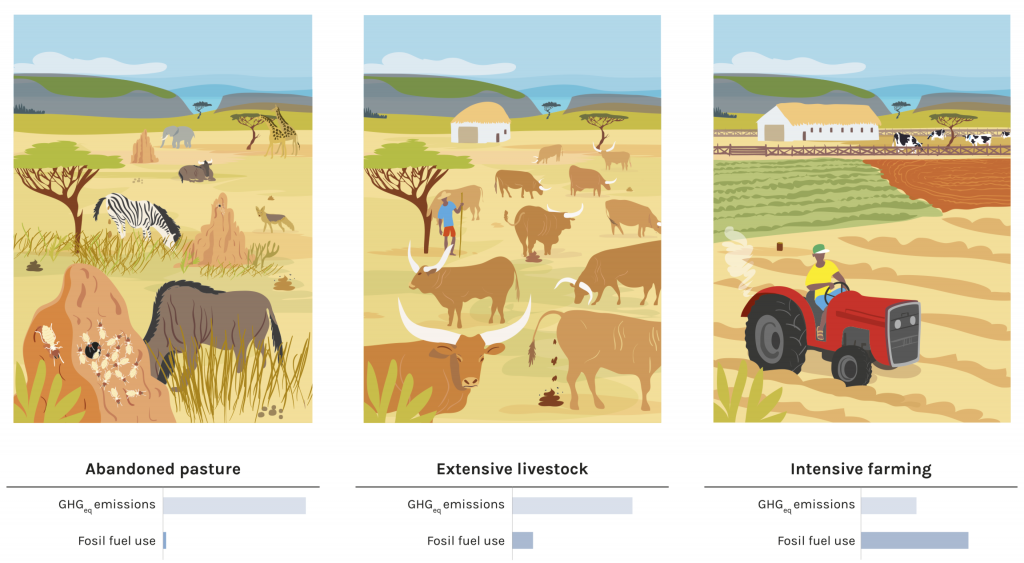“These data show the need to clearly distinguish among different livestock systems when promoting dietary change as a tool to fight against climatic change.”
The discussion on the sustainability of meat is not new here. The HELSUS blog has reviewed the university community’s general satisfaction regarding UniCafe’s decision to remove beef from the lunch menu due to climate concerns. The restaurant frames its decision as part of a rising trend in which plant-based diets are identified as a simple way to move towards sustainability. While grass-fed beef is said to provide valuable ecosystem services, even this production is climatically damaging. But is this the whole picture?
Challenging how livestock climate impacts are measured
Livestock farms differ in their degree of intensification. Industrially raised poultry or pig are permanently confined, do not ever step on a pasture, and feed on grain, crop rests and food wastes. Conversely, mobile pastoralism takes advantage of a variety of plant resources and minimizes external inputs. In between, there are a great variety of livestock systems that exist along an intensification gradient, where animals may get supplementary fodder while they graze, may alternate between confined and free-ranging phases in their lives, or may be fed with harvested hay and grass. From looking at this gradient, research finds that the less intensively livestock is raised, the higher its greenhouse gas emissions are per kg of meat or milk animals. The livestock systems that fare worst in such calculations are ruminant-dominated ones (cattle, sheep, goats, camelids) in low-income countries. This is because of what they eat, as well as because of how their digestive system works. Cellulose from grass, a cheap and abundant source of fodder, is fermented by microorganisms in the gut. Ruminants (and even termites!) can digest these microorganisms, which has given them an evolutionary advantage in rangelands, but this fermentation produces lots of methane – an extremely powerful greenhouse gas.
Both wild and domestic herbivores have rumen, and unsurprisingly, they emit similar amounts of methane when they graze on similar pastures. But – and this is a big BUT – when climate scientists measure greenhouse gases, they only account for those which are produced by our livestock. Those produced by wildlife are not counted because they are considered naturally occurring biotic resources – elementary flows – that are part of the natural system. Even emissions from the digestive systems of pets are not represented in statistics, which only capture emissions from the agricultural system that feeds them. This gives a bad climatic name to pastoralism – the complex socioecological system humans have shaped during millennia to make the most of the world’s rangelands that are not good for crop agriculture. But as humans have encroached on ever-more habitats, the consequent decline in emissions from wild herbivores has gone unaccounted for. Thus, it is not actually possible to say that pastoral practices emit greater greenhouse gas emissions compared to industrial livestock production. And considering the introduction of additional animals into the system (see: pet dogs/cats!), a more nuanced understanding is needed here.

©Inter-Research 2019
Looking at prehistory to understand the whole picture
We don’t have another planet to test what would happen to the atmosphere if we abandoned grazing livestock. But we can observe the fossil record to see what has happened when we massively reduced ruminants. When humans first settled North America, a wave of mammal extinctions ensued. More than 150 species were lost forever in the Americas. The herbivore biomass is likely to have plummeted until survivors took over their ecological niches, such as bison who had had some degree of co-evolution with humans back in Eurasia. The hiatus in methane production is likely to have triggered the Younger Dryas event, a span of nearly 1000 years where Earth seemed to go back into glaciation before finally making it into the Holocene. We also know that the amount of methane emitted by bison before they vanished from the North American Great Plains is roughly equivalent to that currently emitted by grass-fed livestock living on them.
We can therefore understand that the less intensive forms of livestock keeping, i.e. grass-fed livestock, occupy ecological niches that are very similar to those of their wild counterparts and shape similar processes to sustain biodiversity. This largely explains the interest of keeping livestock to avoid the collapse of some valuable ecosystems, such as the critically endangered Finnish grasslands. But it is for the same reason that their real climate effect is much lower than usually assumed. If grazing livestock is abandoned, as has happened in Chernobyl after the nuclear meltdown, wild herbivores take back their ancient ecological niche. Ungrazed biomass also builds up, facilitating the spread of large wildfires that also emit methane and lose carbon stored in the soil.
Better livestock
These data show the need to clearly distinguish among different livestock systems when promoting dietary change as a tool to fight against climatic change. While industrial livestock means a net addition of greenhouse gases into Earth’s atmosphere, zero-input mobile pastoralism that is common in many low-income countries is able to produce valuable meat, milk and fiber at zero climatic cost. It is therefore very important that we do not tar all beef or lamb with the same brush. In addition to the clear climatic, biodiversity, and animal welfare advantages of promoting less intensive livestock systems, preserving a food production system that is mostly held by small farmers is also superior in terms of food sovereignty. We should finally not forget that seminatural grasslands are the only ecosystem in Finland listed as critically endangered, and they are maintained by grazing livestock. So next time you think of doing something for the Earth, don’t think all meat is the same – it’s not the cow, but the how!
Pablo Manzano
Pablo Manzano is a post-doctoral research fellow at the Helsinki Institute of Sustainability Science (HELSUS) of the University of Helsinki. He has worked since 2001 in livestock systems, notably pastoralism, both from the research and the practitioner’s points of view. He has carried out ecological, social and economic research and he has also been part of the staff of international organizations (IUCN, FAO) and performed international consultancies for them and for others (UNEP, IFAD, GIZ or VSF, among others). He has extensive experience in pastoralist and livestock systems of Europe, Africa, Asia and Latin America, as well as good knowledge of the pastoralist grassroots movement. He has also taught ecology/zoology field courses in Kenya and Uganda.
This article is based on the following paper:
Manzano, P.; White, S.R. (2019) Intensifying pastoralism may not reduce greenhouse gas emissions: wildlife-dominated landscape scenarios as a baseline in life cycle analysis. Climate Research 77 (2), 91-97. doi: 10.3354/cr01555 – Available for download at UHelsinki!
Academic papers cited in-line:
Ager, A.A., Lasko, R., Myroniuk, V., Zibtsev, S., Day, M.A., Usenia, U., Bogomolov, V., Kovalets, I., Evers, C.R. 2019. The wildfire problem in areas contaminated by the Chernobyl disaster. Sci. Total Environ. 696, 133954.
Archibald, S., Hempson, G.P. 2016. Competing consumers: contrasting the patterns and impacts of fire and mammalian herbivory in Africa. Phil. Trans. R. Soc. B 371:20150309.
Dass, P., Houlton, B.Z., Wang, Y., Warlind, D. 2018. Grasslands may be more reliable carbon sinks than forests in California. Environ. Res. Lett. 13, 074027.
Deryabina, T.G., Kuchmel, S.V., Nagorskaya, L.L., Beasley, J.C., Hinton, T.G., Lerebours, A., Smith, J.T. 2015. Long-term census data reveal abundant wildlife populations at Chernobyl. Curr. Biol. 25 (19), R824-R826.
Fiala, M., Marveggio, D., Viganò, R., Demartini, E., Nonini, L., Gaviglio, A. 2020. LCA and wild animals: Results from wild deer culled in a northern Italy hunting district. J. Clean. Prod. 244, 118667.
Gerber, P.J., Steinfeld, H., Henderson, B., Mottet, A., Opio, C., Dijkman, J., Falcucci, A. & Tempio, G. 2013. Tackling climate change through livestock – A global assessment of emissions and mitigation opportunities. Food and Agriculture Organization of the United Nations (FAO), Rome.
Holdo, R.M., Sinclair, A.R.E., Dobson, A.P., Metzger, K.L., Bolker, B.M., Ritchie, M.E., Holt, R.D. (2009) A Disease-Mediated Trophic Cascade in the Serengeti and its Implications for Ecosystem C. PLoS Biol 7(9): e1000210.
Hristov, A.N. 2012. Historic, pre-European settlement, and present-day contribution of wild ruminants to enteric methane emissions in the United States. J. Anim. Sci. 90 (4): 1371−1375
Martens, P., Su, B., Deblomme, S. 2019. The Ecological Paw Print of Companion Dogs and Cats. BioScience 69 (6), 467–474.
Poore, J., Nemecek, T. 2018. Reducing food’s environmental impacts through producers and consumers. Science 360 (6392), 987-992.
Smith, F.A., Hammond, J.I., Balk, M.A., Elliott, S.M., Lyons, K.S., Pardi, M.I,, Tomé, C.P., Wagner, P.J., Westover, M.L. 2016. Exploring the influence of ancient and historic megaherbivore extirpations on the global methane budget. Proc. Natl. Acad. Sci. USA 113 (4): 874−879.
Photo by: Ilja Smelich


What conclusion do you draw on the extent of livestock production—perhaps expressed as a dietary pattern—that is consistent with net-zero agriculture/food?